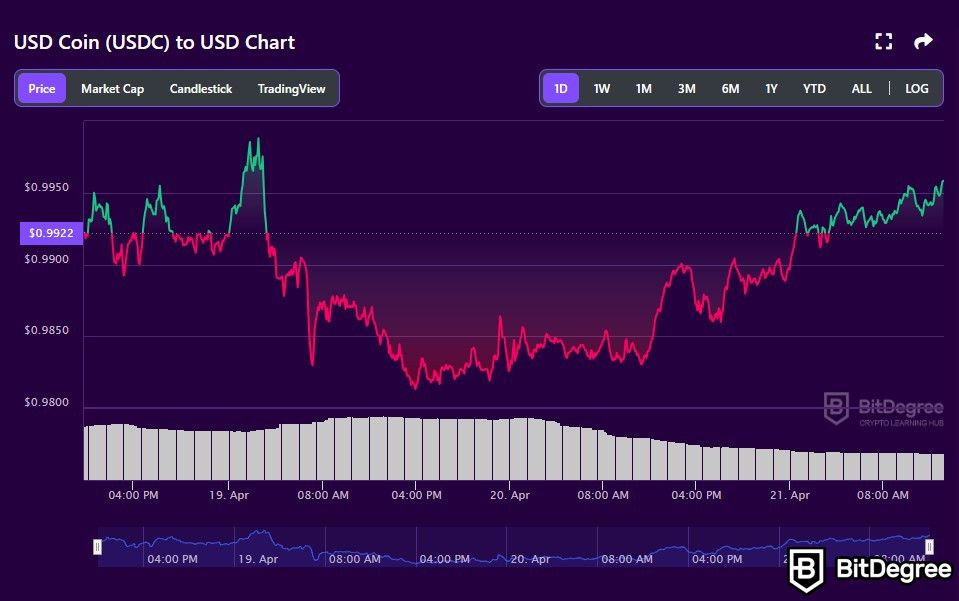Free Airdrop Season 7 is LIVE! Answer fun questions or do simple tasks to earn rewards from the $30K BitDegree prize pool. Participate Now ! 🔥
Diving into the future of cryptocurrency, it’s a thrilling ride filled with big questions and even bigger possibilities. From its early days to the complex landscape today, we've got a lot to cover.
In this article, I will walk you through the history of crypto, spotlight recent innovations shaking up the scene, and take a hard look at the current regulations. Big names like Binance, Coinbase, and Kraken are central to this story, constantly pushing the envelope.
I will also show you some predictions about the future of crypto in the next 5 years and discuss potential hurdles that might pop up along the way. As we explore these topics, one question keeps buzzing in the background: Is crypto the future? Stick with me as we dive into these fascinating aspects, hoping to shed some light on that very question.

Did you know?
Subscribe - We publish new crypto explainer videos every week!
What are Stablecoins, Altcoins & Wrapped Coins Explained!


Table of Contents
- 1. The Future of Cryptocurrency: History and Milestones
- 1.1. Historical Overview
- 1.2. Key Milestones in the Cryptocurrency Market
- 2. Technological Advancements Shaping the Future
- 2.1. Smart Contracts
- 2.2. Decentralized Applications (dApps)
- 2.3. Scalability Solutions
- 2.4. Interoperability Protocols
- 2.5. Privacy Enhancements
- 2.6. Decentralized Finance (DeFi)
- 2.7. Non-Fungible Tokens (NFTs)
- 3. Regulatory and Economic Challenges
- 3.1. Global Regulatory Landscape
- 3.2. Examples of Cryptocurrency Adoption
- 4. The Future of Cryptocurrency: Predictions
- 4.1. Increased Institutional Adoption
- 4.2. Expansion of Decentralized Finance (DeFi)
- 4.3. Mainstream Use of Stablecoins and CBDCs
- 4.4. Broader Integration with Traditional Financial Services
- 4.5. Advancements in Scalability and Interoperability
- 5. The Potential Economic Impact
- 6. The Future of Cryptocurrency: Potential Roadblocks
- 6.1. Security Concerns
- 6.2. Overcoming Public Skepticism
- 7. Conclusions
The Future of Cryptocurrency: History and Milestones
Before we start diving deeper into the future of cryptocurrency, I think it's better to learn where it all began. This will help us understand how it got to this point and predict how the technology and industry will develop in the future.
Latest Deal Active Right Now:Head to BitDegree Missions, gather as many Bits as possible & claim your stake of the $30,000 Prize Pool! Don't waste your time & start collecting Bits by completing Missions and referring friends.
Historical Overview
Cryptocurrency, as we know it today, traces its origins back to the 1980s with the concept of "cryptographic electronic money". However, the real journey began in 2008 when an individual (or group) under the pseudonym Satoshi Nakamoto published the Bitcoin whitepaper. This document laid the groundwork for Bitcoin, the world's first decentralized digital currency, which officially launched in January 2009.
The innovation of Bitcoin was its use of blockchain technology—a decentralized ledger that records all transactions across a network of computers. This ensures security and transparency, as the ledger is immutable and publicly accessible, though identities remain pseudonymous.
Following Bitcoin's launch, numerous other cryptocurrencies emerged. Ethereum, introduced in 2015 by Vitalik Buterin, expanded on Bitcoin's capabilities by incorporating smart contracts into its platform. Smart contracts automatically execute transactions when certain conditions are met, broadening the scope of applications.

As the market grew, so did the ecosystem around cryptocurrencies, including exchanges, wallets, and new funding mechanisms like Initial Coin Offerings (ICOs). ICOs became a popular method for blockchain projects to raise funds directly from future users and investors by selling tokens.
However, the path hasn’t been without bumps. Regulatory scrutiny increased as governments began to recognize the potential for fraud, money laundering, and tax evasion. The volatile nature of cryptocurrency markets led to significant price swings, prompting debates about the stability and long-term viability of cryptocurrencies.
This brings us to a common question: "Is crypto over?" The answer isn't so simple. While the crypto market has experienced downturns, the overall blockchain technology development is still going strong. The reason is that they are still being integrated in various sectors and there's a lot of innovation happening there. I also think it is unwise to determine this based on trends alone.
As we look at where crypto and blockchain stand today, it's clear that these technologies have moved beyond just experiments. They are now almost a regular part of how we handle digital transactions and operations across different sectors.
Key Milestones in the Cryptocurrency Market
While it's still considered new, the crypto landscape has faced several major events throughout its lifetime that affected how it develops. Here are some of the most significant milestones:
- Launch of Bitcoin (January 3, 2009)
The first and most famous cryptocurrency, Bitcoin, was launched on January 3, 2009. It was created by an anonymous person (or group) using the pseudonym Satoshi Nakamoto. Bitcoin introduced the world to the concept of a decentralized digital currency, independent of any government or institution.

Its underlying technology, the blockchain, records all transactions across a network, making it secure and transparent. Bitcoin's creation sparked interest and laid the foundation for the future of cryptocurrency.
- Introduction of Ethereum (July 30, 2015)
Ethereum was introduced on July 30, 2015, by a developer named Vitalik Buterin. Unlike Bitcoin, Ethereum includes a feature called smart contracts, which automatically execute agreements when certain conditions are met.
This opened up possibilities far beyond simple transactions, such as creating decentralized applications (dApps) on the blockchain. Ethereum has been crucial in showing the broader potential of blockchain technology beyond just payments.
- The 2017 Bull Market (December 2017)
December 2017 marked a watershed moment for cryptocurrencies with an unprecedented bull market. Bitcoin's price skyrocketed to nearly $20,000, attracting massive public and media attention. This surge also saw a rise in other cryptocurrencies and introduced many people to the crypto future for the first time. The excitement wasn't to last, however, as the market crashed shortly afterward, leading to significant financial losses for many investors.

- Bitcoin Halving Events (November 2012, July 2016, May 2020, April 2024)
Bitcoin halvings are significant events that occur approximately every four years, where the reward for mining new blocks is halved, thus reducing the rate at which new bitcoins are created. The most recent one happened on April 20th, 2024. These events are important because they directly influence Bitcoin's scarcity and have historically impacted its price. The halvings help control inflation and are watched closely by crypto investors as indicators of potential market movements.
- Major Market Corrections (2018 and 2022)
The cryptocurrency market has seen significant corrections, particularly notable in 2018 and again in 2022. In 2018, following the 2017 boom, prices of major cryptocurrencies plummeted as much as 80% from their peaks, a period now referred to as the "crypto winter".
Similarly, in 2022, another major market downturn occurred, leading to debates about the stability and future of cryptocurrency. These fluctuations underscore the volatile nature of cryptocurrencies but also highlight how market dynamics are maturing as more investors and regulations come into play.
- Rise and Fall of NFTs (2020-2022)
Non-fungible tokens (NFTs) became hugely popular starting in late 2020. NFTs are special digital items like art, music, or videos that you can own, and no one else can have exactly the same one. They became a big deal when people started paying millions for them, even at famous auction houses.
But by mid-2022, the excitement died down, and their value dropped a lot because there were too many out there. Even though interest has cooled, NFTs have changed how we think about owning digital assets and are still part of the conversation about the future of cryptocurrency.

Each of these events has shaped the crypto landscape in significant ways, influencing both public perception and technological advancements. As you can see, not all of them positively impact crypto enthusiasts. Regardless, they still mark major turning points advancing cryptocurrency one step forward.
Technological Advancements Shaping the Future
Exploring the latest developments in blockchain technology gives us a peek into how they might shape the future of cryptocurrencies. Here’s what’s on the horizon:
Smart Contracts
Smart contracts are self-executing contracts where the terms are directly written into code. Using smart contracts, business logic can be automated, and assets such as money become programmable, which opens up previously inaccessible application potential[1]. This technology is vital for the future of cryptocurrency because it makes processes faster and reduces the potential for errors or fraud.
For example, Binance launched its blockchain network called BNB Chain in 2020 which offered compatibility with the Ethereum Virtual Machine (EVM). This allows developers to migrate code from Ethereum to BNB Chain more easily.
As smart contracts become more sophisticated, their potential to revolutionize industries like finance and real estate continues to unfold, reinforcing the role of crypto in future economies.
Decentralized Applications (dApps)
Decentralized applications (dApps) run on a blockchain or peer-to-peer network of computers instead of a single computer, making them more secure and less prone to censorship. dApps are a crucial part of the blockchain ecosystem and are central to enhancing the capabilities of cryptocurrencies.
Nowadays, you can access dApps via your crypto wallet. For example, Kraken has the WalletConnect protocol that lets you connect your wallet to various dApps like MetaMask and Uniswap.
dApps expand the usefulness of cryptocurrencies beyond simple transactions, supporting a variety of services from games to decentralized finance (DeFi). The ongoing development of dApps continues to drive the future of crypto, making it an integral part of the digital landscape.

Did you know?
Subscribe - We publish new crypto explainer videos every week!
DEX vs CEX: Which is Best for YOU? (Explained with Animation)


Scalability Solutions
To ensure that cryptocurrencies can handle increasing demand, scalability solutions like Layer-2 protocols and Sharding are being developed. Layer-2 solutions, such as rollups, operate on top of the blockchain to increase transaction speeds and reduce costs. Sharding divides the blockchain into smaller pieces, making it easier and faster to process transactions.
These innovations are crucial for managing more transactions as the adoption of cryptocurrencies grows. Enhancing scalability is key to the sustainability and efficiency of cryptocurrencies, underscoring their potential as crypto continues to evolve.
Interoperability Protocols
The interoperability within blockchain systems is one of the technology's challenges today[2]. Because of that, several interoperability protocols are developed to enable communication and interaction between different blockchain systems. This innovation is crucial because it allows for the seamless exchange of information and transactions across diverse blockchain networks.

Cross-Chain Interoperability Protocol (CCIP) is a popular interoperability protocol developed by Chainlink. It aims to bridge between traditional financial institutions and both public and private blockchains.
By enhancing interoperability, these protocols help to break down barriers between separate blockchains, making it easier for users to operate across various platforms without restrictions. This development is not only promoting wider adoption but is also shaping the future of cryptocurrency as a unified global digital economy.
Privacy Enhancements
Enhancing privacy in blockchain technology involves creating methods that allow transactions to be more secure and anonymous. Innovations like zero-knowledge proofs provide ways to verify transactions without revealing any sensitive information about the parties involved. This is particularly important as the demand for secure digital transactions grows in our increasingly digital world.
By improving privacy measures, the blockchain community is addressing one of the major concerns users have, thus driving trust and broader acceptance. Such advancements are essential for the sustainable growth of cryptocurrencies and contribute significantly to the optimistic outlook for the future of cryptocurrency.

As we look at these developments, it becomes clear that they are pivotal in determining whether is crypto the future. By addressing current limitations and expanding possibilities, these technologies are laying the groundwork for the future of cryptocurrency, making it increasingly apparent that crypto is indeed a significant part of our future financial landscape.
Decentralized Finance (DeFi)
The term decentralized finance (DeFi) started as an alternative financial infrastructure built on top of the Ethereum blockchain[3]. Now, it is built on various blockchain networks, each with unique characteristics and features. DeFi uses blockchain and cryptocurrencies to manage financial transactions outside traditional banking systems. This includes everything from borrowing and lending platforms to complex financial instruments, all operated on public blockchains like Ethereum.
By removing intermediaries, DeFi offers greater transparency, security, and efficiency, which could redefine banking and finance. The growth of DeFi is a key factor in shaping the future of cryptocurrency, as it promises more accessible and inclusive financial services globally.
Non-Fungible Tokens (NFTs)
NFTs allow the creation of unique digital items that can be bought, sold, or traded. They've become particularly popular in the arts and entertainment sectors, enabling artists and creators to monetize their works directly through digital ownership.
NFTs are expanding to other areas, like real estate and identity verification, which could revolutionize how we think about ownership and exchange in the digital age. Popular exchanges like Binance, Kraken, and Coinbase also have their own NFT marketplaces, allowing more people to buy and sell their digital collectibles.

Although the hype for NFTs has wound down recently, the underlying concept can still be considered a breakthrough that may affect the future of cryptocurrency and blockchain in general. As this technology matures, it could greatly expand the types of assets that can be handled through cryptocurrencies, enhancing the liquidity and market dynamics of digital asset trading.
These advancements suggest a very dynamic future for cryptocurrencies. As these technologies continue to develop and integrate, they promise to make the digital world more decentralized, open, and interconnected than ever before. This is not just exciting for those currently involved with crypto, but also for anyone interested in the potential of digital technologies to transform society and the economy.
Regulatory and Economic Challenges
Another crucial aspect that determines the crypto future is regulations. The government’s attitude towards this digital currency often becomes what makes or breaks the market. Let’s take a look at the current regulatory landscape and some real-life examples of crypto adaptation to help us predict the future of cryptocurrency.
Global Regulatory Landscape
Globally, the approach to cryptocurrency regulation has varied widely. Initially, most governments were slow to regulate because the technology was so new and complex. Over time, as cryptocurrencies gained popularity and their potential impact on the financial system became clearer, countries began to develop more specific regulations.
These ranged from complete bans to creating frameworks that encourage innovation while aiming to protect investors and prevent illegal activities. There are two notable examples of regulatory challenges worth taking a look at:
- South Korea's crypto regulation evolution: In 2017, South Korea initially took a tough stance by banning ICOs due to concerns over potential scams. However, the government has since softened its approach, recognizing the importance of blockchain technology and looking to foster a regulated and thriving crypto market.

- Nigeria’s exchange bans: In a more restrictive move, Nigeria's authorities have taken steps to curb the use of cryptocurrencies by banning popular exchanges like Binance, Kraken, and Coinbase. This has pushed local crypto traders and investors towards more decentralized and peer-to-peer platforms, illustrating how restrictive policies can shift user behaviors rather than eliminate usage.
Looking forward, the future of cryptocurrency regulation seems poised to become more structured and standardized across borders. Here are some predictions:
- Increased international collaboration: Countries might work together more closely to create standardized crypto regulations, which could help manage risks associated with money laundering and terrorism financing.
- Balanced approaches: We may see more countries adopting balanced regulatory frameworks that protect consumers while also promoting innovation in the crypto space. This could involve clearer guidelines on the operations of exchanges, ICOs, and rights of cryptocurrency holders.
- Regulation of emerging technologies: As new technologies like DeFi and NFTs become more prevalent, specific regulations addressing these innovations are likely to be developed.
These evolving regulations are crucial for the future of cryptocurrency as they will help define the operational landscape for all participants. They will also play a significant role in shaping the public’s trust and adoption of crypto technologies.
Examples of Cryptocurrency Adoption
The integration of cryptocurrency into the traditional economy has been a dynamic and evolving process with various notable cases that reveal both the potential benefits and challenges. I have a few examples illustrating how cryptocurrency has been integrated into traditional economic sectors and how these efforts have fared.
El Salvador's Bitcoin Adoption
In September 2021, El Salvador made a groundbreaking move by becoming the first country to adopt Bitcoin as legal tender. This meant that Bitcoin could be used for any transaction where businesses could accept it, from paying taxes to buying groceries.

The government promoted this shift with the introduction of the "Chivo" digital wallet, giving away $30 in Bitcoin to citizens who registered. However, the rollout faced challenges, including technical glitches with the wallet, skepticism from the IMF and World Bank, and protests from citizens concerned about the volatility of Bitcoin. Despite these issues, the move was aimed at reducing remittance costs and boosting financial inclusion.
Recently, the government decided to transfer a significant portion of its Bitcoin reserve to a secure cold wallet. This showcases El Salvador’s belief in the future of cryptocurrency despite the challenges.
Corporate Bitcoin Treasuries
Several corporations have started to hold Bitcoin as part of their treasury management strategies. Notable examples include Tesla, which purchased $1.5 billion in Bitcoin in early 2021, and MicroStrategy, which has made substantial Bitcoin acquisitions as a hedge against inflation.
These moves initially resulted in considerable profits as Bitcoin prices soared, highlighting cryptocurrency as a potential alternative asset for corporate treasuries. However, the volatile nature of Bitcoin also poses risks, as seen during market downturns which can lead to significant balance sheet impacts.
Stablecoins for Cross-Border Payments
Stablecoins like USDC and Tether are increasingly used for cross-border transactions, providing a quicker and cheaper alternative to traditional banking systems. They are particularly useful in countries with unstable currencies or restrictive capital controls.

Their value is pegged to stable assets like the U.S. dollar, which reduces volatility and makes them more suitable for commerce. The use of stablecoins highlights the potential for cryptocurrencies to improve the efficiency of international money transfers.
These examples really show us the mixed bag of outcomes when it comes to mixing cryptocurrency with traditional economic systems. On one hand, there are some undeniable perks like slashed costs, quicker transactions, and better access for everyone.
But on the flip side, we're still wrestling with issues like the wild swings in value, murky regulations, and some tech hurdles that can be tough to navigate. The journey of these pioneers is going to be key in figuring out the future of cryptocurrency and how it fits into our everyday economy.
The Future of Cryptocurrency: Predictions
Trying to figure out what the future of the cryptocurrency market will look like is always tricky. It’s very volatile and the tech behind them keeps changing super fast. But, based on what's happening right now and where things seem to be heading, here are a few educated guesses about the future of crypto in the next 5 years:
Increased Institutional Adoption
We're likely to see more big players, like companies, pension funds, and even governments, start dipping their toes into the cryptocurrency market. They're getting more interested because the assets are maturing and the rules around them are becoming clearer.

In fact, we have witnessed JPMorgan Chase, Goldman Sachs, BlackRock, and Fidelity recognizing the potential of blockchain technology. As these big players start including cryptocurrencies in their investment portfolios, it can help legitimize and stabilize the market.
Expansion of Decentralized Finance (DeFi)
The DeFi sector is really picking up steam and it looks set to keep growing. We're talking more complex services on the horizon, like insurance, derivatives, and some really sophisticated lending platforms. As it grows, we can expect beefed-up security and tougher regulations to come into play, making sure that users stay safe while they dive into these new financial opportunities.
Mainstream Use of Stablecoins and CBDCs
As the tech gets better and the rules around it get clearer, expect stablecoins and Central Bank Digital Currencies (CBDCs) to really hit the mainstream. This shift could totally change the game for things like sending money across borders, remittances, and even your daily transactions. Imagine getting things done faster, cheaper, and more efficiently than traditional banking.
Broader Integration with Traditional Financial Services
As cryptocurrencies and blockchain technology keep improving, they're going to weave their way more into traditional financial services. This means the lines between your usual financial products and crypto innovations are going to get pretty blurry. We can expect some innovative twists in banking, finance, and insurance that take full advantage of what blockchain has to offer.

Advancements in Scalability and Interoperability
With technology like sharding, Layer-2 solutions, and cross-chain protocols on the rise, we're looking at some solid fixes for those pesky scalability issues that have been bugging blockchains. These improvements mean transactions could zip through faster and more smoothly. Plus, different blockchains will be able to chat and share info way more effectively.
The Potential Economic Impact
As cryptocurrencies become more common, they'll impact the traditional economy in various ways. Crypto can drastically reduce transaction fees, especially internationally, by bypassing banks and payment processors.
It also offers financial services to those who are unbanked or underbanked, particularly in areas where traditional banking isn't available. This could boost economic participation and security. Cryptocurrencies encourage innovation like DeFi, which proposes alternatives to standard banking.
However, there are downsides: cryptocurrencies are volatile, which could lead to financial losses, and their environmental impact, particularly from mining, raises sustainability concerns. Additionally, as crypto gains traction, traditional financial institutions might lose revenue, shifting the economic landscape of the financial sector.

In essence, while we can definitely gain many benefits from integrating cryptocurrencies into our day-to-day economy, it is not ideal to do it in its current state. There are numerous areas that require improvement, including regulatory measures and the underlying technology itself.
One approach stakeholders can use to mitigate the potential risks is implementing a crypto-sandbox enhancement of the current regulations. This crypto sandbox will include payment players and specific testing for special cyber-security attacks and economic changes[4] before implementing it in the real-life economic landscape.
The Future of Cryptocurrency: Potential Roadblocks
While we examine the future of cryptocurrency, it is also important to understand the hurdles that may occur. Here are two main potential roadblocks for the crypto future that stakeholders need to anticipate:
Security Concerns
Security concerns are a big hurdle for the future of cryptocurrency. As these digital currencies become more popular, they also become juicier targets for hackers. Take, for example, the massive $530 million snatch from Coincheck in 2018, or the Poly Network heist where over $600 million was initially stolen. These aren’t just costly blunders—they shake trust in the safety of cryptocurrencies.
Now, with such glaring breaches, some might wonder, "Is crypto over?" But don't count it out just yet. Looking ahead to the future of crypto in the next 5 years, it’s clear that ramping up security will be key to winning over the public and ensuring cryptocurrencies stabilize and grow.

To tackle these security snags, a few steps can make a big difference. Beefing up encryption to guard transaction data better, adding layers like multi-factor authentication, and encouraging the use of hardware wallets can help keep crypto thieves at bay. Plus, more exchanges and wallet providers are moving towards decentralized setups, spreading data across various nodes to avoid a single point of failure.
And let’s not forget about educating users on how to keep their digital wallets safe. As we all get smarter about security, combined with stronger tech defenses, we can keep pushing toward a safe and thriving future of cryptocurrency.

- Secure and reliable
- Accepts fiat currencies
- Lots of trading options
- Reputable exchange
- Accepts fiat currencies
- Offers various trading options

- Fiat currencies - accepted
- Simple to use
- Accepts only the most trustworthy cryptocurrencies
- A leading cryptocurrency exchange platform
- Best for beginner investors
- Accepts fiat currencies

- Beginner-friendly
- Secure
- Decent trading and withdrawal fees
Overcoming Public Skepticism
Public skepticism is another big roadblock in the future of cryptocurrency, especially with all the ups and downs we’ve seen. So, how can the crypto market overcome this skepticism in the next 5 years? It’s going to take a combination of transparency, education, and solid regulation.
First off, more transparency about how cryptocurrencies work and how they’re secured can demystify a lot of the concerns people have. Showing real-world success stories and clear, reliable growth data can also help turn skeptics into believers. Plus, education plays a massive role. The more people understand about crypto, the less daunting it seems. So, ramping up educational efforts to explain the nuts and bolts of crypto could really shift public perception.
And, let’s not forget regulation. Stable and sensible regulations can make the whole crypto space feel safer and more legitimate. They reassure everyone that there’s a safety net, which can be a huge relief for those sitting on the fence about crypto.
By tackling these areas, we can foster greater trust and acceptance, proving that crypto is not over. Instead, these efforts can secure a robust and respected future of cryptocurrency. As we move forward, the future of crypto in the next 5 years looks bright, ready to win over the skeptics and grow even stronger.
Conclusions
Looking ahead, the future of cryptocurrency is buzzing with potential and debates. For it to really hit its stride, better regulations and advancements in blockchain technology are absolutely essential. These improvements aren't just about making things safer and building trust; they're also about aligning with global financial standards to encourage broader adoption.
Popular exchanges like Binance, Coinbase, and Kraken, alongside big investment companies such as BlackRock and Fidelity, are right at the heart of shaping the future of cryptocurrency. Their efforts in creating solid frameworks will be crucial for reducing the risks associated with digital currencies and unlocking their full potential to transform how we manage money globally.
So, what does the future of cryptocurrency look like in the next 5 years? We're likely to see more user-friendly platforms and groundbreaking financial products that could completely change the game in wealth management, trading, and personal finance.
And for those wondering "Is crypto over?"—it's clear that we're just getting started. With the right tweaks and innovations, crypto could move from a niche interest to a mainstream financial asset, playing a big role in the economic landscape.
The content published on this website is not aimed to give any kind of financial, investment, trading, or any other form of advice. BitDegree.org does not endorse or suggest you to buy, sell or hold any kind of cryptocurrency. Before making financial investment decisions, do consult your financial advisor.
Scientific References
1. Ante L.: 'Smart Contracts on the Blockchain – A Bibliometric Analysis and Review';
2. Belchior R., Vasconcelos A., Guerreiro S., et al: 'A Survey on Blockchain Interoperability: Past, Present, and Future Trends';
3. Schär F.: 'Decentralized Finance: 'On Blockchain- and Smart Contract-Based Financial Markets';
4. Dennis NG, Griffin P.: 'The Wider Impact of A National Cryptocurrency'.













